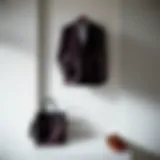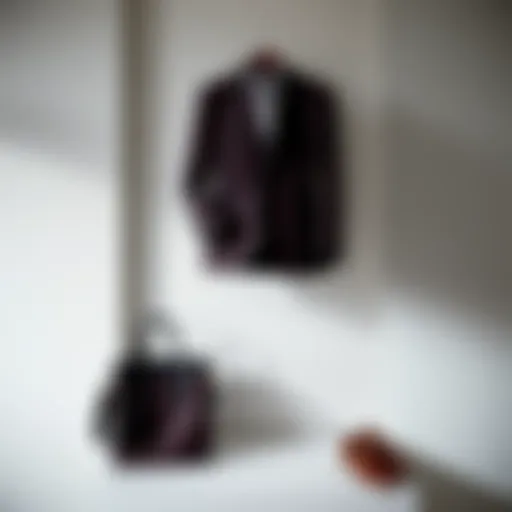The Allure of the 1920s Evening Wrap: A Timeless Fashion Statement


Intro
The 1920s marked a revolutionary period in women's fashion, characterized by a playful elegance and a departure from the restrictive garments of previous decades. The evening wrap, a staple of this glamorous era, served not just as an accessory but as a symbol of freedom and modern femininity. This article delves into the charm and allure of the 1920s evening wrap, highlighting its evolution, significance, and types of materials that defined its essence. We'll also explore its contemporary relevance and how to integrate this timeless piece into today's wardrobe.
Fabric Knowledge
Understanding the materials used in evening wraps helps appreciate their beauty and utility. Fabrics from the 1920s were not just varied in appearance but also in texture and weight, each offering unique styling options.
Types of Fabrics
In the 1920s, evening wraps came in a variety of luxurious fabrics, including:
- Silk: Renowned for its smooth, lustrous finish, silk wraps elegantly drape over evening gowns. Their soft touch adds a touch of opulence to any outfit.
- Satin: With a glossy surface, satin evening wraps were popular choices. They catch the light beautifully, making them ideal for glamorous events.
- Chiffon: Light and airy, chiffon wraps offered a delicate layer that was perfect for warm evenings. The sheer quality added an ethereal touch to the ensemble.
- Velvet: While a heavier option, velvet wraps exuded luxury and warmth, making them suited for winter soirées. Their rich texture provided a sumptuous finish.
- Tulle: Often seen in layered wraps, tulle adds volume and movement. Its playful nature reflects the spirit of the roaring twenties.
How to Care for Different Fabrics
Maintaining the allure of your evening wrap requires understanding how to care for these delicate materials properly. Here are some care tips:
- Silk & Satin: Hand wash in cold water with mild detergent. Air dry to prevent damage.
- Chiffon: Use a gentle cycle if machine washing. Always hang to dry to maintain its flowy character.
- Velvet: Spot clean with a damp cloth. For deeper cleaning, consult a professional cleaner to keep its plush surface intact.
- Tulle: Lightly steam to remove wrinkles; avoid direct contact with water as it may lose shape.
Style Tips
Integrating an evening wrap into your wardrobe can elevate your style, whether you're dressing for a formal event or a casual night out. Here are some strategies to consider:
Outfit Pairing Strategies
Pairing your evening wrap requires some thought. Here are suggestions to ensure you’re always looking chic:
- With Little Black Dresses: A classic choice that never goes out of style, an evening wrap can enhance the sophistication of an LBD.
- Over Glamorous Gowns: Choose a wrap that complements the gown's color and fabric for a cohesive, polished look.
- Casual Attire: Don’t shy away from draping a more casual outfit with a chic wrap to add a layer of elegance without much effort.
Seasonal Fashion Trends
When styling your evening wrap, consider the season:
- Spring & Summer: Light fabrics like chiffon or silk are refreshing choices. Florals or pastels often peek through.
- Fall & Winter: Heavier materials like velvet or satin provide warmth. Darker hues like deep red or emerald resonate nicely with autumn motifs.
"The evening wrap is not just a piece of clothing; it's a connection to a vibrant era, full of life, liberty, and style."
Prelims to 1920s Evening Wraps
The 1920s, often dubbed the Roaring Twenties, was a decade that wove together the threads of change, creativity, and a newfound freedom in women's fashion. At the heart of this sartorial shift lay the evening wrap, a garment that captured the essence of an era marked by elegance and boldness. The evening wrap was not merely an accessory; it was a symbol of liberation and style. In this exploration, we will delve into the historical context, cultural influences, and notable characteristics of the evening wrap, all of which combine to reveal its enduring appeal.
Historical Context
The backdrop of the 1920s was a world still reeling from the aftermath of World War I. This conflict not only reshaped global politics but also influenced societies on personal levels. Women, having stepped into roles traditionally held by men during the war, began to seek more than just functional clothing; they desired garments that encapsulated their newfound independence. The evening wrap emerged as a response to this desire, characterized by designs that embraced fluidity and movement, reflecting a break away from the rigid styles of the previous decades. The wraps were often opulent and glamorous, designed for soirées and gatherings in a society that was now more vibrant than ever.
Cultural Influences on Fashion
Fashion in the 1920s was heavily influenced by various cultural movements and artistic expressions, from the rise of jazz music that encouraged lively social dancing to the burgeoning film industry that put stars in the spotlight. Figures such as Coco Chanel began to revolutionize women's fashion, promoting a silhouette that was both practical and chic. The evening wrap became a canvas for artistic expression, featuring rich fabrics, intricate embellishments, and dramatic silhouettes, which appealed to women seeking to make a statement.
“Fashion is architecture: it is a matter of proportions.” — Coco Chanel
As the shadows of the past faded, this garment also communicated a shift in gender norms. The wraps became a means for women to assert their individuality, elegance, and sensuality. Whether adorned with feathers or fringes, each wrap told a story of its wearer, echoing sentiments of sophistication that resonated through roaring ballrooms and intimate gatherings.
In summary, the evening wrap of the 1920s not only served a practical purpose but also reflected a significant cultural moment, embodying the spirit of women stepping into their own. This exploration of its historical roots and cultural ramifications sets the stage for a deeper understanding of the evening wrap's defining characteristics and its lasting influence on modern fashion.
Defining Characteristics of Evening Wraps
The evening wrap is not just an accessory, it’s a distinct representation of the style and sensibilities of the 1920s. Understanding its defining characteristics provides insight into how this piece contributed to the ethos of modern femininity during a time of remarkable change. An evening wrap is more than a simple garment; it is woven with cultural significance and reflects the influences of the era.
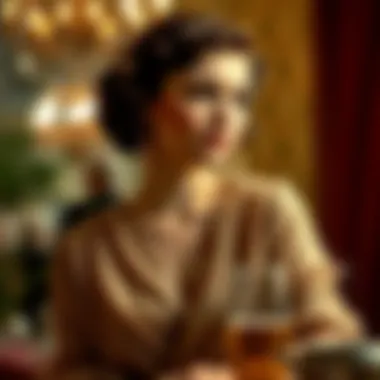

Design Features
Design features are vital as they inform how well the evening wrap serves its purpose—both functional and fashionable.
Silhouette
The silhouette of an evening wrap is crucial, offering a visual appeal that balances elegance with sophistication. Most wraps of the 1920s embraced a fluid design, often with a loose drape that fell gracefully over evening gowns. This oversized look allowed for both comfort and style, ensuring the wearer could glide through a ballroom with ease. A notable advantage of such a silhouette is its versatility; it can flatter various body types, enhancing the overall figure without being constricting. The airy illusion it offers has made it a beloved choice in contemporary adaptations as well.
Length and Fit
Length and fit are essential characteristics that dictate how an evening wrap interacts with the rest of an outfit. The wraps were often designed to reach anywhere from the hip to the ankle, providing options for different occasions and evening styles. An appropriately fitted wrap ensures it doesn’t overshadow an elegant dress, maintaining a sense of proportion. Furthermore, the adaptability of length—from shorter capes to longer, flowing pieces—allows for both casual and formal styling. The freedom of fit also contributes to its popularity; it caters to the wearer’s comfort while still making a statement.
Closure Options
Closure options offer practical functionality and aesthetic appeal. The traditional choices of a wrap range from open-front styles that flow freely to closures employing hooks, buttons, or sashes. These varied closures allow the wearer to adjust the fit according to weather conditions or personal preference. Open-front wraps provide a more relaxed vibe, while those with closures can add a tailored edge to an ensemble. Being able to secure a wrap adds an element of versatility, facilitating an easy transition from one setting to another—be it an elegant gala or a casual dinner party.
Material Choices
Material choices play a significant role in determining the evening wrap's presence and overall look. Using different fabrics not only affects its weight and feel but also influences how the design characteristics are perceived and experienced by the wearer.
Common Fabrics Used
In the 1920s, evening wraps were predominantly created from luxurious fabrics such as silk, satin, and velvet. These materials were favored not just for their rich appearance but also for their soft drape, which further accentuated the graceful silhouette. Silk, for example, reflects light beautifully, adding a touch of sophistication and glamour, while velvet contributes a plush, rich texture that invokes a sense of opulence. The choice of fabric directly impacts the garment’s overall aesthetic—creating a tactile relationship between the piece and the wearer's body. However, high-end materials can come with the downside of requiring special care, limiting usability outside formal settings.
Textural Elements
Textural elements add depth and character to the evening wrap. Fringes, embroidery, and lace trims can transform a straightforward design into an extraordinary statement piece. These details create a tactile experience that attracts the eye. Intricate beading or sequin embellishments can elevate a wrap to new heights, allowing it to dazzle in the candlelight of a ballroom. However, these embellishments can sometimes pose challenges regarding maintenance and weight, potentially making the wrap less practical for frequent wear.
Color Palettes
Color palettes are fundamental in the evening wrap's allure, offering options that resonate with different moods and occasions. The 1920s embraced a rich spectrum; jewel tones like emerald green and ruby red were particularly favored for their striking impact. Nonetheless, softer shades like pastel pinks and creams were also used, tending to invoke a more delicate or romantic aesthetic. These colors not only reflect individuality but also symbolize various social dynamics of the time—bold hues representing the jazz age's exuberance and pastels hinting at elegance. The choice of color can be a double-edged sword; while vibrant colors draw attention, they may not blend seamlessly into all wardrobes, requiring careful consideration in pairing with other garments.
"The charm of the evening wrap lies in its ability to serve as both a stylish accessory and a cultural artifact, encapsulating the transformative era of the 1920s."
Understanding the defining characteristics of evening wraps is essential for recognizing their enduring legacy in fashion. These elements speak not just to the fabric and design but also carry the weight of societal changes, offering a glimpse into how women chose to express themselves during a time of liberation and bold style.
Iconic Figures and Their Influence
The 1920s was a decade that reverberated with socio-cultural changes, and the evening wrap found itself at the forefront of this fashionable evolution. Iconic figures, both from Hollywood and the fashion sphere, played pivotal roles in popularizing the evening wrap, lending it an air of prestige and desirability. Their contributions extended beyond mere aesthetics; they encapsulated the spirit of an age pushing boundaries, discarding old norms, and embracing new ideologies about femininity and self-expression.
Famous Wearers
Hollywood Stars
In the glitzy world of Hollywood, the likes of Clara Bow and Greta Garbo adorned evening wraps, making them synonymous with glamour. These stars radiated charm and allure, showcasing how evening wraps complemented not just their gowns but also their enticing personas. Clara Bow, often dubbed the ‘It Girl,’ happened to be seen draped in delicate satin wraps, emphasizing her status.
The significant trait of these wraps was that they elevated the entire ensemble, wrapping the wearer in an aura of elegance. Stars embraced the evening wrap for its versatility, demonstrating that a simple statement piece could transform an outfit from ordinary to extraordinary in a blink. Moreover, these stars were not simply wearing garments; they were influencing trends, making night wraps a staple for upscale gatherings.
One unique feature of Hollywood's influence was how stars made evening wraps accessible to the masses. The styles they flaunted in films often trickled down to everyday fashion, demonstrating that glamour could slip into the lives of average women.
However, these wraps' cinematic allure sometimes created unrealistic expectations; not every woman could mirror the effortless grace displayed on screen. Still, the desire they ignited persisted, pushing fashion boundaries and encouraging women to explore their personal styles.
Fashion Icons
Beyond tinsel town, fashion icons like Coco Chanel and Elsa Schiaparelli also left indelible marks on the evening wrap trend. Coco Chanel, with her revolutionary approach to women’s clothing, introduced a sense of ease and comfort. She emphasized how the evening wrap could meld into daily life, creating a seamless transition between day and night apparel.
Chanel's signature style broke away from constricting garments, advocating for comfort without sacrificing elegance. The evening wrap, therefore, became a canvas for personalization, allowing women to express their individual tastes. The fabrics and design choices championed by Chanel were not only chic but also practical, bridging the gap between functionality and style.
Conversely, Elsa Schiaparelli added theatrical flair to evening wraps with bold colors and surreal embellishments, indicating how fashion could be a dialogue of art. This creativity encouraged women to embrace a more expressive approach to evening wear. Schiaparelli's wraps often blended unexpected materials, fostering a sense of artistic freedom.
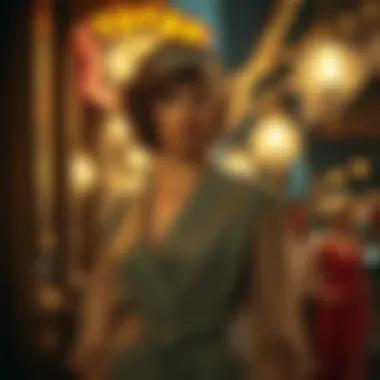

While fashion icons played a crucial role in shaping the evening wrap, their styles also highlighted the evolving notions of femininity during the 1920s, presenting the evening wrap as a manifestation of personal identity.
Fashion Houses of the Era
Maison Worth
Maison Worth stands out as a significant contributor to the evening wrap's evolution during this fascinating decade. Founded by Charles Frederick Worth, the house redefined haute couture, pioneering techniques that would shape the future of fashion design. Evening wraps from Maison Worth often embodied luxurious simplicity, prioritizing quality craftsmanship that allowed fabrics to drape elegantly. This renowned house catered to the elite, establishing a standard of sophistication revered to this day.
The hallmark of Maison Worth was how it tailored wraps that could easily uphold a woman's stature while also providing a sense of ease. Such versatility made these pieces favorable for occasions ranging from formal dinners to high society events. While the craftsmanship ensured an exquisite look, these evening wraps also provided warmth and comfort, showcasing an understanding of both fashion and function.
However, access to Maison Worth wraps remained limited to the affluent, often sidelining the average woman. This exclusivity underscored not only the aspirational nature of fashion at the time but also the societal stratification that often accompanied it.
Paul Poiret
Then comes Paul Poiret, known for his audacious spirit and fearless approach. Known for liberating women from the confines of corsets, Poiret’s evening wraps took a more artistic route. His creations often lacked traditional linear constraints, allowing for a free-flowing silhouette that harmonized with the essence of the 1920s woman. This innovative take represented the newfound freedom women sought amidst shifting societal norms.
The key characteristic of Poiret's evening wraps was an embrace of cultural motifs, inspired by global influences. His works often showcased vibrant colors and lavish embellishments, inviting an appreciation for artistic expression. Poiret not only dressed women for occasions but also sought to empower them through fashion, weaving stories of individuality into each fabric.
However, Poiret's focus on drama and boldness might not appeal to every woman, creating a divide in preferences. Nevertheless, his impact on evening wraps left an important legacy, blending art with wearability in a way that would encourage future designers.
The evening wrap truly thrived in an era characterized by spirited change, influenced heavily by these figures. Their artistry and boldness in style did not just adorn their silhouettes; they also mirrored the societal shifts defining the modern woman of the 1920s.
Functionality of the Evening Wrap
The evening wrap is not merely an accessory for 1920s fashion; it embodies a blend of style and purpose that elevated women's wardrobes during the decade. This versatility allowed the wrap to become a necessary part of the evening ensemble, signifying social status and personal taste. Key aspects like versatility in styling and practicality in use highlight the evening wrap's dual role as both a fashion statement and a functional garment that supports the modern woman's lifestyle.
Versatility in Styling
Layering Techniques
Layering is an important feature of the evening wrap. It allows wearers to mix and match various garments, letting them express their personality while adapting to changing environments. This technique plays a key role in maximizing the use of the evening wrap, as it can be worn over different outfits to alter the overall aesthetic.
Imagine attending a sumptuous dinner party. By layering your wrap over a sleek black dress, you can instantly elevate your look with a dash of elegance – a luxurious touch that shrouds the silhouette in intrigue. Layering also leads to unexpected surprises; a striking brooch pinned onto the wrap can transform the vibe from simple to striking in an instant.
Unique Features and Benefits
Layering offers several advantages: it provides visual depth, allows for easy adjustments in temperature, and enhances the versatility of the evening wrap. However, one must be cautious about over-layering, as it can result in a bulky appearance, losing the grace that characterizes this timeless piece.
Transitioning from Day to Night
The ability of the evening wrap to facilitate a seamless transition from day to night is another hallmark of its functionality. This quality comes particularly in handy for modern women juggling multiple commitments across their busy schedules. With just a quick switch, the wrap can transform a daytime outfit into something suitable for an evening gathering.
Embracing the casual vibe of daytime with a tailored dress is one way to wear the wrap. When night falls, simply draping the evening wrap over the shoulders transforms the look, adding a touch of sophistication and allure that's perfect for a sophisticated soirée.
Unique Features and Benefits
This flexibility is valuable, allowing for quick wardrobe changes without compromising style. However, care is needed to ensure that the wrap harmonizes with the rest of the outfit; a poorly coordinated ensemble can detract from the overall effect.
Practicality in Use
Comfort and Mobility
Comfort and mobility play crucial roles when discussing the evening wrap’s practicality. The beauty of this garment lies not only in its aesthetic appeal but also in its ability to enhance the wearer's freedom of movement. In a time when women's fashion was beginning to shift towards more liberating designs, the evening wrap offered both style and ease.
This means feeling at ease while navigating crowded parties, dancing at social events, or simply mingling during formal occasions. Unlike cumbersome, fitted outerwear, evening wraps can drape, float, and move fluidly with the wearer, contributing to an overall sense of comfort.
Unique Features and Benefits
The light fabric often used in evening wraps ensures the wearer doesn't feel restricted. However, it's worth noting that some styles endorse an oversized fit, which may require caution to avoid being cumbersome.
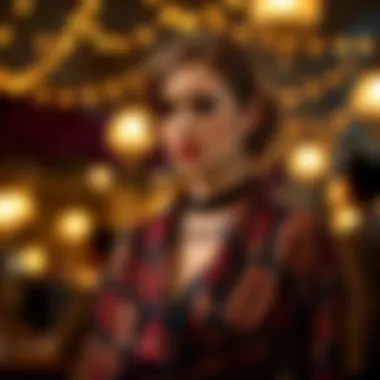

Protection from Elements
Another essential feature of the evening wrap is its ability to offer protection from the elements. While it is not a heavy duty coat, the wrap serves as a light shield against evening chills or sudden breezes. The 1920s were known for their elegant dressing, and this included considering the practical aspects of garments.
When stepping out on a cool night, a silk or velvet evening wrap can serve to keep the chill at bay while still looking spectacular. Its ability to cocoon the wearer's shoulders creates that needed warmth without sacrificing elegance.
Unique Features and Benefits
Thus, the evening wrap stands as a bridge between stylish appearance and practical utility, ensuring the wearers are wrapped in beauty while staying comfortable in unpredictable weather. Irregular weather is always a concern, and wraps shouldn't replace heavier coats completely. Nonetheless, they offer a stylish way to navigate through chilly evenings gracefully.
Cultural Implications of the Evening Wrap
The evening wrap of the 1920s was more than just a fashion accessory—it was a profound cultural symbol. This garment echoed the shifting tides of societal norms, capturing the essence of a decade that prided itself on progressive ideas and liberation. With the evolution of the evening wrap, fashion began to reflect broader cultural narratives, particularly on issues like women's rights and changing attitudes towards gender roles.
Fashion as a Statement
Women’s Liberation Movement
The 1920s was a pivotal time for women stepping into their own power, and fashion clued into this revolutionary spirit. The evening wrap flourished as a manifestation of women's liberation. This wasn’t merely about comfort or style; the wrap served as a powerful statement of individuality. It represented an era where women were embracing independence, flouting imposed norms, and claiming a freedom of expression that hadn’t been culturally accepted before. The key characteristic of this movement was the push for equality, both socially and politically. By making bold fashion choices, women signaled their determination to break away from traditional constraints.
- Defining Features: The evening wrap itself embodied this spirit. Its fluid lines and luxurious fabrics offered both elegance and mobility, highlighting a woman's capability to navigate public spaces with confidence. Women no longer felt required to conform to the restrictive silhouettes of the past.
- Advantages: This laid the groundwork for future fashion, influencing designers to create garments that valued practicality alongside aesthetic charm. The accessibility of stylish evening wraps allowed more women to adopt these garments into their wardrobes, making statements in every social setting.
Changing Gender Norms
The evening wrap also played a critical role in the shifting perceptions of gender. In many ways, it challenged the traditional confines of masculinity and femininity, allowing for a hybrid identity—a blend where women could feel free to express themselves beyond societal binaries. The evening wrap was more than an item of clothing; it became a powerful emblem of the times when roles and expectations were being rewritten.
- Key Characteristic: The unique feature of how wraps could be styled in various ways helped blur the lines of rigid gender definitions. Women could wear it elegantly draped over evening gowns or casual attire, showcasing versatility in style that resonated with their newfound freedom.
- Consequences: The acceptance and embrace of this shift in gender norms laid foundational ideas that would evolve into future fashion revolutions. Designers began interpreting gender fluidity more seriously, resulting in a wider array of styles considered suitable for all bodies, regardless of gender.
Impact on Contemporary Fashion
The legacy of the 1920s evening wrap continues to inspire modern fashion designers today. The rich historical significance coupled with its aesthetic appeal has birthed a revival in vintage styles. Not only do we see elements of the wrap in contemporary garments, but we also sense an undercurrent of those earlier cultural revolutions, echoed through modern interpretations.
Revival of Vintage Styles
Today, the revival of vintage styles is a striking testament to the enduring allure of past fashion trends. Garment like evening wraps are now seen in various high-fashion collections, often reimagined yet holding onto the exquisite details that made them timeless. This nostalgia speaks to consumers’ desires for authenticity and connection to history, illuminating why such styles remain appealing.
- Key Feature: Many modern pieces draw their inspiration from the wraps' silhouettes and luxurious fabrics, highlighting a recurring theme of seeking comfort and elegance. The inherent glamour of the wrap resonates with style today just as it did a century ago.
- Significance: This revival benefits both retailers and consumers by creating a market for eco-conscious fashion. Wearing vintage often goes hand-in-hand with sustainable practices, thereby appealing to a growing demographic of environmentally aware shoppers.
Modern Interpretations
Alongside the revival, we also witness modern interpretations of evening wraps that cater to contemporary aesthetics and practicalities. Designers have taken the fundamental essence of these wraps and infused them with innovative materials and techniques, allowing for versatility that suits the fast-paced lives of today’s consumers.
- Characteristic Aspect: Features like adjustable lengths, detachable ornaments, and innovative closures reflect a recognition of the diverse needs of wearers, marrying utility with elegance. Such adaptations bridge the gap between vintage charm and modern convenience.
- Advantages: While maintaining the elegance expected of an evening wrap, these adaptations often enhance the garment's functionality, making it a staple in the modern wardrobe.
As we explore the cultural implications of the evening wrap, it is clear that its influence traverses time, continuing to impact our perception of fashion, identity, and autonomy. The wrap is not just a piece of fabric; it symbolizes a journey of personal expression that remains relevant today.
Epilogue: The Enduring Legacy of the 1920s Evening Wrap
The evening wrap from the 1920s stands as a significant marker of societal change, weaving together threads of style, practicality, and the bold assertion of feminine identity. As we draw together the various elements discussed in this article, it becomes clear that the evening wrap transcends mere fashion; it represents an attitude towards life and self-expression.
Lasting Impact on Fashion Trends
The influence of the 1920s evening wrap can still be felt in today's fashion landscape. Modern designers often reference this era, drawing inspiration from its opulent fabrics and clean lines. The wrap's versatility made it a go-to piece for a multitude of occasions. It showed us that elegance doesn't always mean sacrificing comfort.
- Versatile Styling: Today, evening wraps can be dressed up with intricate embellishments or toned down with casual outfits, making them a staple in many wardrobes.
- Material Revivals: Fabrics like silk, satin, and velvet that were so crucial in the 1920s have seen a resurgence, with contemporary interpretations that include new textures and patterns.
- Inclusivity in Design: The evening wrap has evolved to cater to all body types and personal styles, marrying historical charm with modern sensibilities.
Fashion enthusiasts can take cues from this era, remixing traditional elements with modern-day necessities. The wrap may come off the runway or be found in boutiques, still echoing the luxurious simplicity of yesteryears.
"Fashion fades; style is eternal." – Yves Saint Laurent
Future of the Evening Wrap
Looking ahead, the evening wrap's place in fashion seems secure. As sustainability becomes a buzzword, the evening wrap stands out as a garment that can be both timeless and eco-friendly. The growing consciousness about fashion ethics encourages consumers to invest in pieces that last, rather than fleeting trends.
- Sustainable Fashion: Expect to see evening wraps being crafted from reclaimed materials or organic textiles, continuing the trend of merging style with sustainability.
- Modern Innovations: Advances in fabric technology could introduce innovative designs that did not exist in the 1920s, such as moisture-wicking materials or adaptive fits.
- Cultural Integrations: As the fashion world becomes increasingly global, we might see the evening wrap being fused with international styles, leading to exciting hybrid designs.
As we move forward, the evening wrap serves as a canvas for creativity, telling stories of resilience, elegance, and adaptability. It beckons designers and wearers alike to explore its rich legacy while forging new paths in fashion's ever-evolving tapestry.








